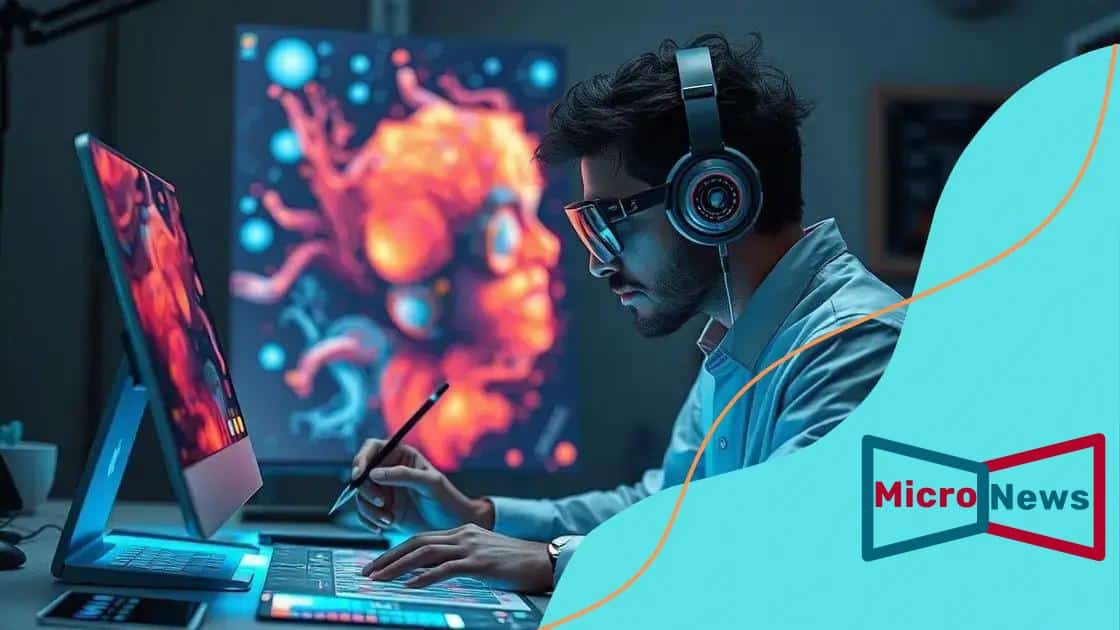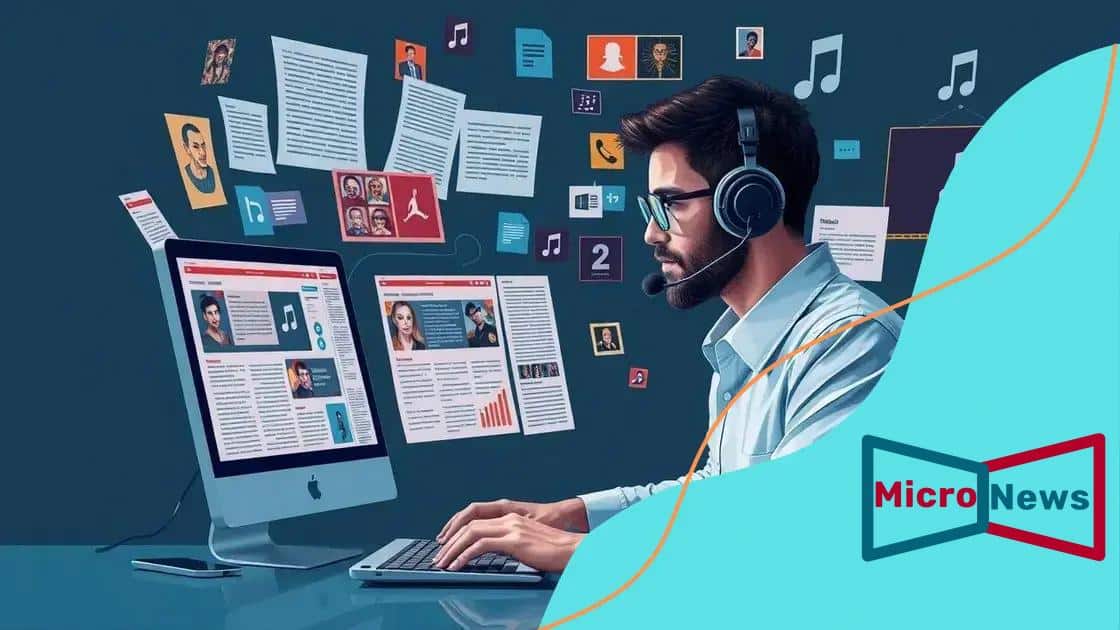The role of AI in transforming the creative industries

The role of AI in transforming the creative industries includes enhancing collaboration, personalizing audience experiences, and raising ethical concerns regarding originality and copyright ownership.
The role of AI in transforming the creative industries has become a hot topic as technology continues to blend with human imagination. Have you ever wondered how AI influences your favorite art forms?
How AI is shaping creativity
As we explore how AI is shaping creativity, it becomes clear that this technology is not just a tool but a collaborator in the creative process. Artists, designers, and musicians are increasingly turning to AI to enhance their work and push the boundaries of their imagination.
AI brings a unique perspective, often introducing elements that a human mind might overlook. For instance, AI can analyze vast amounts of data to identify trends and styles, providing artists with insights that inspire new creations. This capability allows for an evolution in artistic expression, where technology and human creativity unite.
The role of AI in visual arts
When it comes to visual arts, AI assists artists in multiple ways. It can generate stunning visuals, create complex patterns, and help in concept development. Here are a few ways AI contributes:
- Image generation: AI tools like DALL-E and Midjourney create lifelike images from text prompts.
- Style transfer: Artists can apply the style of one artwork to another, making unique combinations.
- Collaboration: AI can propose variations, giving artists new directions for their work.
The integration of AI in the music industry is equally transformative. Musicians are using AI to create compositions, analyze song structures, and even produce sounds. This has led to innovative genres and a more experimental approach to music-making.
Advancements in the music industry
AI’s capabilities in music highlight how it can shape creativity:
- Composition tools: AI can assist in writing melodies and harmonies, enhancing artistic productivity.
- Sound design: It can generate new sounds or modify existing ones, broadening sonic landscapes.
- Audience analysis: AI tools analyze listener preferences, helping artists tailor their music effectively.
Ultimately, AI is reshaping not only how artists create but also how audiences experience art. The fusion of AI with creativity opens new doors to exploration and expression.
Applications of AI in various artistic fields
Exploring the applications of AI in various artistic fields reveals a dynamic interplay between technology and human creativity. Artists are embracing AI to enhance their craft and produce innovative works that were previously unimaginable.
In visual arts, AI tools are revolutionizing how artists create and conceptualize their work. For example, many artists now utilize algorithms to generate unique patterns and textures. This enables them to explore new styles and ideas that can push the boundaries of traditional art.
AI in graphic design
Graphic designers are harnessing AI for several impactful applications:
- Automated layouts: AI can create visually appealing designs without manual input, saving time and effort.
- Image editing: Advanced tools can enhance or alter images, making the design process quicker and more efficient.
- Logo generation: AI algorithms can generate logos based on brand values and concepts, offering fresh ideas to designers.
This automation allows designers to focus more on the creative process while leaving repetitive tasks to AI. In the realm of music, AI is being used to compose songs, analyze patterns, and even create backing tracks. Musicians are experimenting with AI-generated sounds to expand their musical repertoire.
AI in music production
The integration of AI in music production offers several advantages:
- Songwriting assistance: AI can suggest lyrics or melodies, stimulating creativity and collaboration between artist and machine.
- Sound synthesis: New sounds can be created through AI algorithms that explore audio possibilities beyond human capabilities.
- Audio mixing: AI techniques can optimize sound mixing, ensuring tracks are polished and professional.
These applications demonstrate how AI is not just a tool but a partner in the creative process, fueling innovations across artistic disciplines. As artists continue to explore the potential of AI, we can expect even more exciting developments in the future.
AI-generated content and its implications

Examining AI-generated content and its implications reveals how this technology is reshaping various industries. From writing articles to creating music, AI is changing the landscape of creative content.
One significant impact of AI-generated content is its ability to produce large volumes of work quickly. For instance, AI can create news articles or marketing content in a fraction of the time it would take a human. This efficiency can benefit businesses by streamlining content production processes.
Benefits of AI-generated content
AI tools provide several advantages:
- Cost-effective: By automating content creation, companies can reduce labor costs and save time.
- Consistency: AI ensures that the tone and style of the content remain uniform across all outputs.
- Scalability: Businesses can easily increase the amount of content produced to meet growing demands.
This automation is not without challenges. While AI can quickly produce content, it sometimes lacks the depth and emotional nuance that human writers bring. There are concerns about originality, as AI often relies on existing data to generate new content. This raises questions about copyright and authenticity in creative works.
Ethical considerations
As AI-generated content becomes more prevalent, ethical considerations are critical:
- Plagiarism risks: AI systems may inadvertently produce content similar to existing works.
- Job displacement: The rise of AI could threaten jobs in writing and creative fields.
- Quality control: Ensuring that AI-generated content meets high standards is essential for maintaining credibility.
Overall, while AI-generated content offers exciting opportunities for efficiency and creativity, it also presents significant ethical and practical challenges. Balancing innovation with responsibility will be key as we move forward.
Challenges faced by creatives using AI
Exploring the challenges faced by creatives using AI highlights the complexities of integrating technology into the artistic process. While AI offers innovative tools and possibilities, it also presents unique obstacles that artists must navigate.
One primary concern is the potential for loss of originality. As AI systems generate content based on existing data, artists fear their work may become derivative, lacking the personal touch and perspective that only human creativity can provide. This challenge raises questions about what constitutes true artistry in a world where machines can replicate styles and ideas.
Intellectual property issues
Another significant challenge is related to intellectual property rights. When AI generates art, who owns the copyright? This legal gray area creates uncertainty for artists who use AI tools. They must navigate complex licensing agreements while ensuring that their own creative contributions are protected.
- Creative ownership: Establishing who holds the rights to AI-generated work can be complicated.
- Plagiarism concerns: AI may produce content that closely resembles existing works, leading to potential legal disputes.
- Royalty distributions: Defining how profits are shared from AI-generated content can create conflict.
Also, there exists a challenge in adapting to rapidly evolving technology. Artists may find themselves struggling to keep up with new AI tools and techniques. This constant change can be overwhelming and may lead to frustrations when attempting to learn how to effectively use AI in their creative practices.
The human element in creativity
Despite the possibilities AI presents, there is a vital need for the human element. Creativity is rooted in emotion, experience, and personal expression, which are aspects that AI cannot replicate fully. Artists often grapple with balancing their artistic voice while using AI as a tool, ensuring that they remain authentic amidst the growing influence of technology.
As artists navigate these challenges, it is crucial for them to find their own balance between utilizing AI and maintaining their unique perspectives. The integration of AI into creative fields is a complex journey that requires adaptability, critical thinking, and an understanding of the implications it brings.
Future perspectives of AI in the creative sector
Looking ahead at the future perspectives of AI in the creative sector shows a landscape filled with exciting potential and possibilities. As technology continues to advance, AI will likely play an even more significant role in how we approach creativity.
One of the most promising aspects is the ability of AI to enhance collaboration. Artists, musicians, and designers will increasingly rely on AI as a partner, providing unique tools that inspire innovation. AI can offer suggestions, analyze trends, and even help brainstorm ideas, pushing creative boundaries further.
Personalized experiences
Another anticipated development is the personalization of content. With AI analyzing user preferences, creatives can produce tailored experiences that resonate more with audiences. This could lead to:
- Custom art: Works of art specifically created to match individual tastes and styles.
- Tailored music: Playlists that adapt to listener moods in real-time.
- Interactive storytelling: Narratives that change based on audience choices and interactions.
Such personalization can create deeper connections between artists and their audiences, fostering a richer cultural experience. Furthermore, AI will continue to evolve in its ability to assist across different forms of artistic expression.
Ethical standards and guidelines
As we move forward, establishing ethical standards will become crucial. As AI tools become more integrated into creative processes, society must address issues like originality, ownership, and the impact on traditional roles. This will involve:
- Educating users: Helping artists understand how to use AI responsibly.
- Creating policies: Ensuring fair practices regarding AI-generated content.
- Encouraging innovation: Supporting new ideas while respecting human creativity.
The future of AI in the creative sector holds immense promise. By embracing these changes thoughtfully, artists can unlock new forms of expression while preserving the core values of human creativity. As we explore these possibilities, the partnership between AI and creativity will shape an engaging and dynamic future for the arts.
FAQ – Questions about the role of AI in the creative industries
How does AI enhance collaboration in creative fields?
AI tools can help artists and creatives brainstorm ideas and explore new concepts, acting as a partner in the creative process.
What are some ethical concerns related to AI-generated content?
Concerns include issues of originality, copyright ownership, and the potential displacement of jobs in creative industries.
How can AI personalize experiences for audiences?
AI can analyze user preferences to tailor content, such as customized art, music playlists, and interactive stories.
What is the future of AI in the creative sector?
The future includes enhanced creativity, personalized content, and the establishment of ethical standards to guide AI use in the arts.





